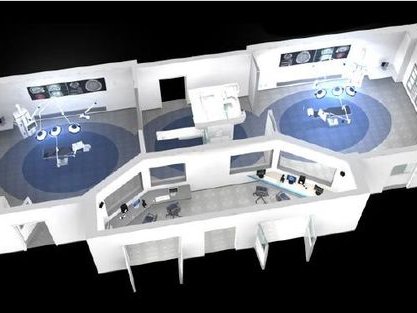Hybrid Operation Theatres Based on the IMRIS Technology
Similarly as in other spheres of human activity, the latest technological knowledge is applied in the health sector as well. Medicine possesses the means of advanced imaging technology, which can be used to verify, optimize, and correct the course of even the most demanding neurosurgeries and perform important intraoperative checks that were previously unthinkable. In technologically advanced countries, the method of image-guided surgeries, which is similar to the hybrid facilities implemented in radiotherapeutic practice by the company Elekta under the term image-guided radiation therapy (IGRT), is being increasingly more applied in surgical and neurosurgical practice.
The architecture of new operating theatres and the modernization of existing operating theatres comes from the logical layout according to the procedures that are performed on a patient with the use of intraoperative diagnostic imaging techniques in a microbially safe environment. Thereby, the highest quality of procedures as well as the patient's safety are guaranteed. The currently recommended and demanding procedures with adequate equipment and numerous multi-field team cannot be performed in standard operating theatres. Therefore, operating theatres with an area of 60 to 80 m2 where up to twelve-member operating teams can work are becoming commonplace.
Intraoperative checks can be performed in a clean environment and in real time by ultrasonic (e.g.SonoWand) or X-ray devices already today. In many cases it is necessary to use magnetic resonance (1.5 or 3 T) for a reliable localization which is more sensitive and operates without radiation load. For operating theatres designed in such a way, the terms multifunctional operating theatre (MFOT) or hybrid operation theatre started to be used. The creative Professor Lüder Clausdorff from the University of Applied Sciences in Giessen is the pioneer of this new concept.
The most important partner for image-guided surgeries in the field of neurosurgery, neuronavigation, microneurosurgery and cerebrovascular patients care is the Canadian company IMRIS, which improved them by new arrangements and the dissemination of imaging devices in operating theatres. According to the medical purpose, a mobile magnetic resonance or CT with ceiling suspension is integrated in the relevant operation wing of the facility. This enables the operation of multiple operating theatres for example, two in a mirroring position, or even other combinations see the following schematic representation.
MRISneuro / IMRIScardio The layout of 3 theatres for neurosurgery and interventions
The layout of the room and interior equipment in accordance with the IMRIS concept increases the use of expensive diagnostic devices and accelerates the performance of surgical procedures. Due to the possibility of immediate intraoperative inspection directly on the operating table, the quality of the surgical procedures and patient safety are increased. It is possible to reduce the operating costs, increase the throughput of operating theatres and reduce their number. More than 40 distinguished facilities abroad have been equipped according to this principle. Some of them are listed below:
Children's Hospital of Atlanta. Atlanta, GA Barnes Jewish Hospital St. Louis, MO Mayo Clinic Jacksonville, FL Princess Margaret Hospital Toronto, ON, Canada Cleveland Clinic Cleveland, OH Yale-New Haven Hospital New Haven, CT Canberra Hospital – Canberra, Australia Health Science Centre . Winnipeg, MB, Canada Johns Hopkins Hospital Baltimore, MD Massachusetts General Hospital . Boston, MA The Royal Children's Hospital Melbourne, Australia The closest ones in Europe: CEA-Clinatec in Grenoble and the Neurosurgical Clinic in Tübingen
The realisation of such investment takes place rapidly in countries with stabilized private medical insurances and where high emphasis is placed on the revitalization of patients.
The new conception in the layout of facilities is ideal for patients undergoing cardiac surgery in the field of cardiovascular and transplant surgery. It causes less pain, reduces the healing period and also seriously reduces the risk of infection and other complications. Wide treatment possibilities open up in the diagnostics of diseases of the heart and large blood vessels and in the subsequent invasive or surgical treatment. Modern spatial arrangement simultaneously combines the advantages of the classical surgical operating theatre and the imaging possibilities of intervention laboratories with higher comfort for patients and doctors. As a result of new technical possibilities, multi-functional teams are formed which are able to determine the exact indication and subsequently take care of the flawless performance of the relevant procedures. The emergence of modernly designed facilities is important because the existing borders between the different intervention areas are gradually disappearing and in addition, in the near future modern medicine will not be able to make do with the traditional or strict division of fields into cardiac surgery, interventional cardiology, interventional radiology and angiology. Due to the enormous progress in the development of medical technologies, particularly in the area of cardiovascular surgeries, certain types of surgical procedures can be performed already now in a significantly less invasive way than before, with greater comfort and higher safety for the patient.
By their frequency and severity, cancer and vascular diseases of the brain represent the most important areas of intracranial neurosurgery. The current development of neurosurgery is moving towards minimally invasive and comprehensive treatment of lesions (i.e. radical removal of the tumour, complete closure of the vascular malformation), elimination of risks and possible negative consequences of the surgical procedure. The main prerequisites for achieving this objective are the modern microneurosurgical procedures enabling the surgeries of complex as well as deep lesions with minimal brain retraction and risk of damage to the nerve and vascular structures. Neuronavigation and functional neuronavigation enable precise preoperative planning and intraoperative orientation. Intraoperative and functional magnetic resonance offers an accurate morphological display of intracranial structures in the course of the surgical procedure and increases the accuracy of the neuronavigation. Electrophysiological monitoring increases the security of the neurosurgical procedure by monitoring the brain and nerve functions. A successful result of the surgery is achieved only by combining all the available methods.
THE FIRST PUBLISHED STUDIES OF THE IMRIS SYSTEM SHOW POSITIVE RESULTS
TRANSKONTAKT-MEDICAL s.r.o is an authorized distributor of the products of the company IMRIS.
More details available at www.imris.com or transkontakt@medicaltk.com

